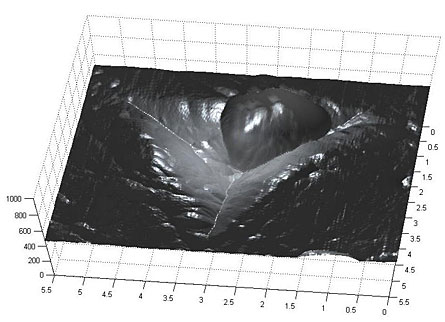- More than 2 years ago
Concrete creeps. And now scientists think they know why.

New measurements suggest that the rearrangement of nano-sized concrete particles is responsible for the way buildings, bridges and other load-bearing concrete structures deform over time, a process technically known as “creep.” The new insight could allow engineers to make stronger and longer-lasting concrete, researchers report in a study to be published online in the Proceedings of the National Academy of Sciences.
Creep limits the life span of a building or bridge, deforming its structure and leading to instability, says Franz-Josef Ulm of MIT, a coauthor of the study. “It’s a little like chewing gum,” Ulm says. Gum will stretch and compress if a constant force is applied. “Concrete does exactly that, but at a much larger scale.”
But the process is slow, taking many years, and has been difficult to pin down, Ulm says.
Ulm and Matthieu Vandamme, of the Université Paris-Est in France, focused on one of the fundamental building blocks of cement paste, which requires the addition of small rocks called aggregate to make concrete. Cement paste consists mainly of calcium silicate hydrate, called C-S-H. C-S-H particles, thought to be about 5 nanometers in diameter, give concrete much of its strength and durability.
To measure creep, the team took nine samples of cement paste, each with a different density, and applied constant pressure with a needle for three minutes. Scientists determined how much creep the needle caused during that time — typically a 40- to 50-nanometer indentation.
The denser the cement, the slower the creep, the researchers discovered. Ulm and Vandamme inferred that the nano-sized particles of C-S-H are shifting in relation to one another. Denser concretes experienced less creep since there was less space between particles and therefore less room for movement.
The team also found that the creep rate matched that of other granular materials, such as sand, further supporting their conclusion.
Although scientists can’t stop the creep, understanding how it works could help them slow it down.
“The classical approach is empirical: You introduce some new substance into [the concrete mix], and see, ‘Oh it creeps less,’” Ulm says. Scientists have stumbled across recipes for stronger concrete—by adding silica fumes, for example—but they did not understand why these additions resulted in slower-creeping concrete. Nanoengineering concrete would allow scientists to design the type of material they want from the bottom up.
“If everything in this paper proves to be correct, then there are specific strategies suggested that would allow us to design a chemical that would reduce or increase creep,” says Hamlin Jennings of Northwestern University in Evanston, Ill.
Using the ultra high-density concrete for structures that must last a long time — like bridges and nuclear waste containers — could increase the life span of those structures “from maybe a hundred years to 40,000 years,” Ulm says. “You’d never have to worry again about creep.”







